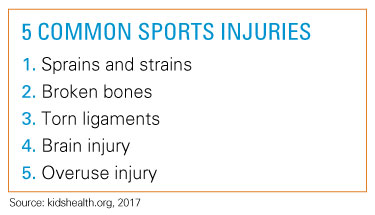About 30 million children and teens participate in some form of organized sports, and each year more than 3.5 million are injured.1 By following a few basic sports safety tips, kids can prevent more than half of these injuries, according to the Centers for Disease Control.
Learn about preventive care for kids
Children are more at risk for sports injuries
Sports can do more than keep kids fit and healthy. They help build confidence, self-worth and social skills. They teach preteens and teens how to work as part of a team and focus on achieving a goal.
But playing sports also puts children at risk of serious injury. Their bodies are still growing, so bones, tendons and muscles can be damaged more easily than in adults. In fact, injuries that might cause only minor damage in an adult can lead to serious injury or trauma in a growing child.
Contact sports like hockey, football and soccer top the list when it comes to causing injury. The body parts most commonly injured in sports include the ankle, head, fingers, knees and face. While sprains and strains are most common, broken bones, torn ligaments and brain injuries also top the list.
Top sports safety tips
For kids, not being able to play the games they love is often the worst part of having an injury. Teaching young athletes about sports safety can help prevent and reduce injury on and off the playing field.
Here’s how to protect kids from sports injuries:
- Schedule a pre-season physical exam. Before the playing season begins, have your kids checked out to make sure they’re able to participate in the activity. Be sure to provide a full health history.
- Talk with the coach. Explain any health conditions your child has that may require special attention.
- Allow time to warm up. Set aside time before every practice and game. Start with light activity like jogging. Then stretch all major muscle groups.
- Help athletes to stay hydrated. Be sure they have a full water bottle and encourage them to drink before, during and after every practice and game.
- Get the right gear and be sure it fits. Be sure the gear is right for the sport and fits your child properly. Helmets, shin guards, mouth guards, ankle braces and shoes with rubber cleats can help prevent or reduce the severity of injuries.
- Take time off. Young athletes should take one or two days off each week from any one sport to help avoid overuse injury.
Know the signs of concussion
Concussions can happen in all youth sports. They account for more than half of all emergency room visits by children between the ages of 8 and 13.2 Young brains are especially at risk.
If your child receives a head injury, see your doctor even if you don’t need emergency care. Do not let your child return to play while signs of a concussion are present.
Signs of concussion
Signs of a concussion may not show up right away. Some symptoms can last for days, weeks or even longer. Here’s what to watch for:
- Headache
- Confusion
- Memory loss
- Dizziness
- Ringing in the ears
- Nausea
- Vomiting
- Fatigue
- Dazed feeling
- Poor concentration
- Sensitivity to light or noise
- Sleep disturbance
Emergency room, urgent care or doctor’s office?
When sports injuries do happen, it’s important to get the right care. But when should you go to the emergency room or urgent care clinic? And when does it make sense to wait and talk with your doctor?
- Head injuries: Go to the emergency room or urgent care clinic if the child has lost consciousness, is confused, vomiting or not acting normal.
- Neck injuries: Head for the emergency room if there is numbness, tingling, weakness or if the child is unable to talk or swallow
- Hits to the chest: Go to the emergency room if chest pain is intense or the child has shortness of breath. Urgent care may be an option if there is no shortness of breath and the child can manage the pain.
- Muscles, tendons and bones: Go to the emergency room if a limb looks deformed and your child cannot put weight on it. Go to an urgent care clinic or see your doctor for swelling, bruising and pain with movement.
Blue Cross is here for your health
Blue Cross and Blue Plus make it easy to get answers to your health questions. If you are a member, you have online access to doctors and a 24-hour nurse line. You also have a variety of health resources at your fingertips.
If you do not have health insurance, Blue Cross and Blue Plus offer a range of health plans to meet your needs and budget. All health plans include preventive care coverage along with tools and resources to help you stay healthy and protect the health of your entire family. Talk with an agent to learn more.
More about preventive care
Preventive care for kids age 6-12
Dental care for children
Vaccines for teens and tweens
Vaccines for children

